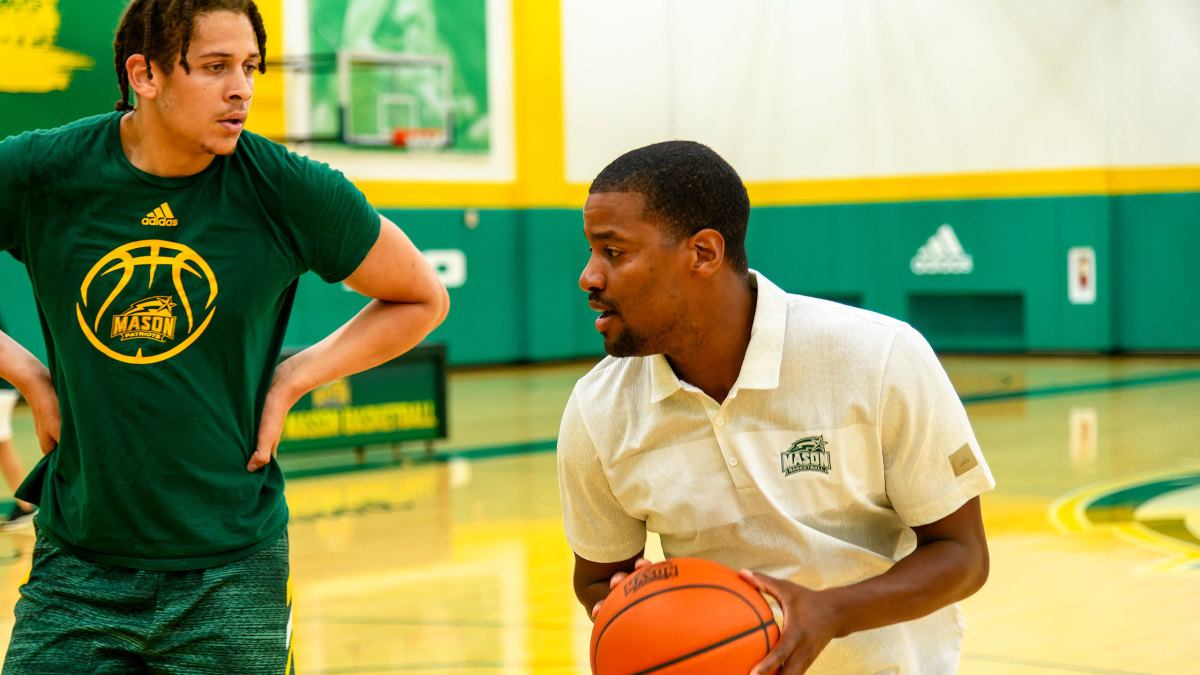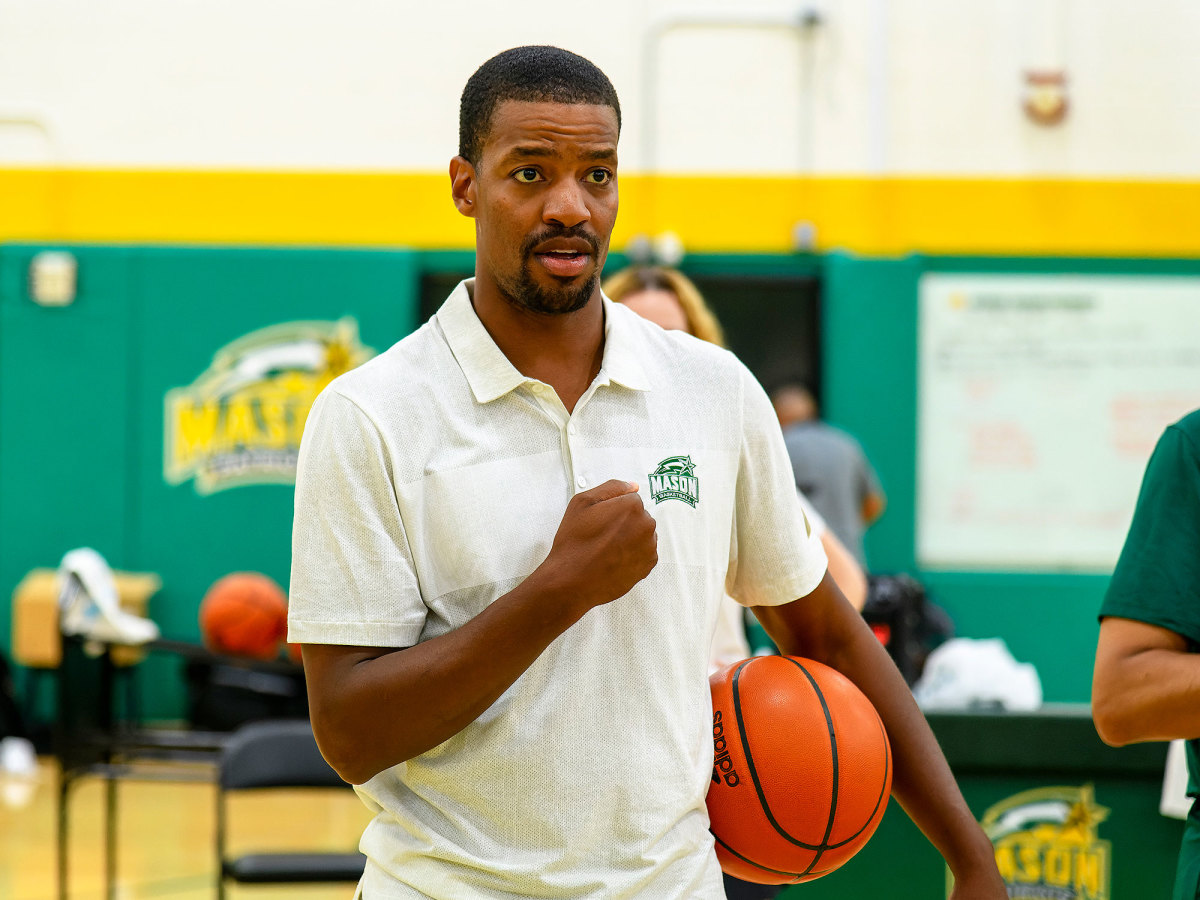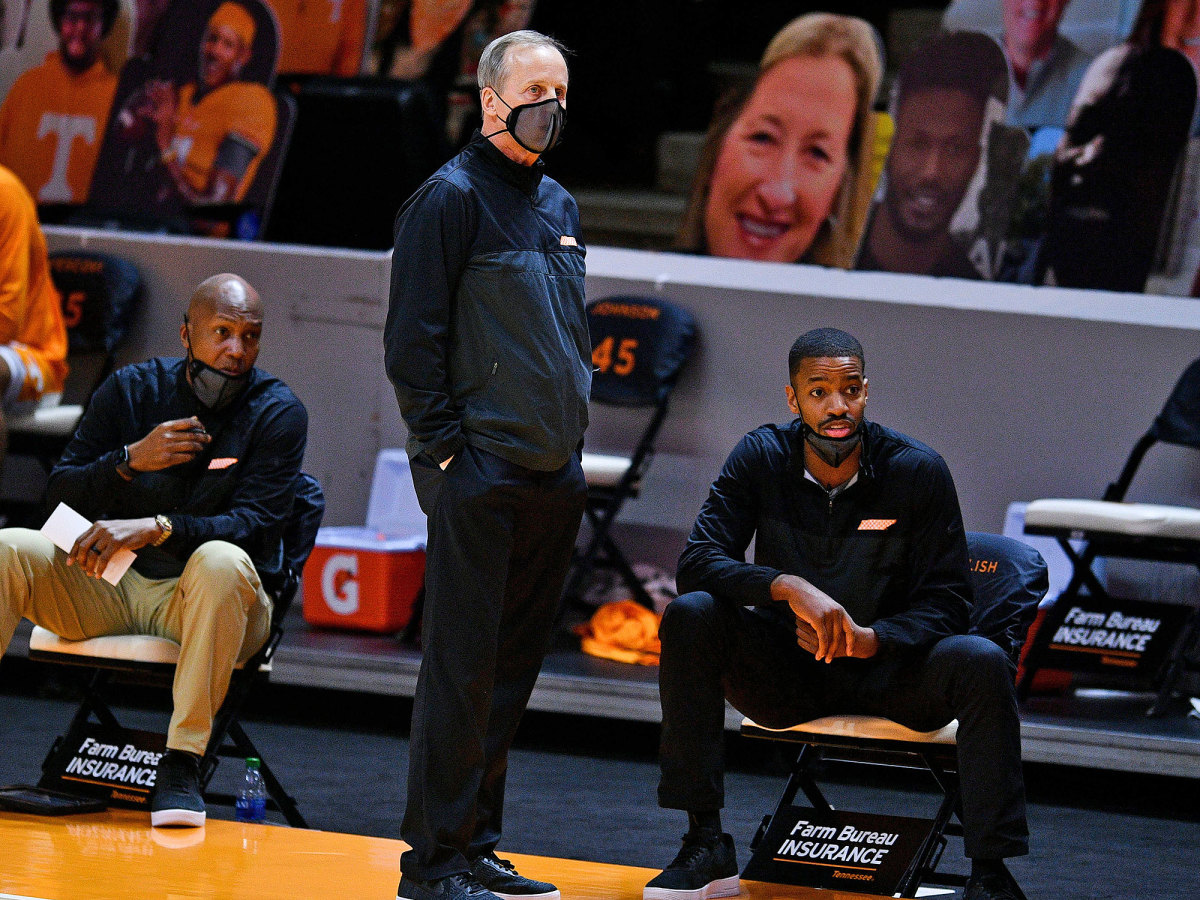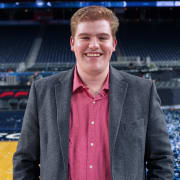Ahead of the Curve: Nine Years After Turning Pro, Kim English Takes the Reins at George Mason

For most of college basketball, mid-August is vacation time.
Players, finished with the grind of summer workouts and classes, head home before the semester begins. Coaches, who spent June and July weekends on the road recruiting and weekdays running workouts, catch flights to a beach and recharge the batteries before the team returns.
But on this humid Monday morning in Fairfax, Va., the scene is far from a vacation. The George Mason men’s players that are still in town (about half of the roster) are in the team’s practice facility for workouts well before 9 a.m. Leading that workout is the new head coach of the Patriots, Kim English. English still looks young enough to be a support staffer hoping for his first big break and fit enough to hop on the court and dominate the players he’s currently coaching.
Well, English is young enough to be a support staffer and he does sometimes ditch the whistle to hop in on five-on-five runs with his current players. At 32 years old, English is the fourth-youngest head coach in Division I men’s basketball. He’s less than a decade removed from getting drafted into the NBA out of Missouri by the Detroit Pistons. But at the age that many former players start lining up what’s next, English is several months in as a head coach in the Atlantic 10, at a program that was in the Final Four 15 years ago. To say he’s ahead of schedule would be an understatement.

Perhaps that’s the goal of this morning’s workout: to get ahead of schedule. There’s an attention to detail about it that you won’t find everywhere. At one point, English takes the time to show his players how VCU will trap them on the sideline and how to get out of it … at least four months before his team will play against the Rams. When the team starts a shooting drill, English steps in to demonstrate a near-full-speed rep to set the tone for the team. He may be young enough to be still playing, but there’s little doubt when watching him command this practice that Kim English was made to be a coach.
“He’s got the ‘it,’ ” says Frank Haith, who coached English at Missouri and later hired him as an assistant at Tulsa. “The kids are going to love him. He’s going to have great presence and passion with him because he’s going to build relationships and trust. He’s an unbelievable communicator and he’s brilliant.”
English began preparing for this moment before his playing career concluded. Most college assistants have a blueprint of sorts written down of what they’ll do when they eventually get a head coaching job. English started his in 2014, while he was still fighting for a spot in the NBA. Now, the document is 40 pages long and includes everything from core philosophies to assistant coaches and staffers he’d consider hiring. Two of the names on his prospective coaches document are now on staff with him.
“I still look at it every day,” he says.

English spent the first year of his professional career with the Pistons, playing in 41 games as a rookie in the 2012–13 season. It would be his only season in the NBA—he was cut the following July and never appeared in another league game.
“I learned more in that one season than I have ever learned in any basketball situation in my life,” English says. “It sparked a learning curve that really hasn’t stopped.”
English loved the NBA not for the money or the extravagant travel, but for the knowledge. He says being around NBA coaches changed the way he sees the game for good.
“These great minds that I was talking to, conversing with, learning from every single day, it was like utopia for me,” English says.
While fighting to keep his NBA career alive, English headed overseas to Italy and later France. He spent training camp with the Chicago Bulls in 2014, where he says he built much of his current defensive philosophy through watching Tom Thibodeau work every day. But he was cut and headed back to France, where he played for two teams in the fall of ’14. It didn’t suit him the way the NBA did.
“It was just different,” English says. “The learning curve wasn’t satisfying my taste anymore. I wanted to get back to learning.”
One way he kept his brain occupied: scouting. English would make scouting reports for Haith, who had taken the head coaching position at Tulsa that year. He’d watch film of Tulsa and their opponents before writing up detailed reports to send to Haith.
“It was great stuff,” Haith says. “I was like, Man, he’s got it; he’s good.”
The Tulsa coach believes those scouting reports served another purpose than just a helping hand.
“He wanted to prove to me he was passionate about it,” Haith says. “That was his way of working me, of proving to me that it wasn’t just lip service, that this was truly what he wanted to do.”
It worked. English played briefly in Venezuela that spring before retiring from basketball, less than three years after being drafted. He was hired immediately by Haith at Tulsa as director of player development at the age of 26, and less than a year later had been promoted to assistant coach. And thus began English’s fast-track from player to head coach: two years at Tulsa, two at Colorado under Tad Boyle and two at Tennessee under Rick Barnes, who coincidentally also got his first head coaching job at George Mason, also at the age of 32.
The rather abrupt and early end to English’s professional playing days might have been a challenge to reconcile for some players. Not for English.
“It wasn’t difficult for me because my love was the game,” he says. “I still get to play the game.”
At every stop along his coaching journey, English has gotten his playing fix by playing against his own players, both one-on-one and five-on-five. And when he does get on the hardwood, he’s not taking it easy on anyone.
“When I step on the court, if they want to knock the s--- out of me to box-out, they can,” English says. “I’m going to knock the s--- out of them.”
Lil post practice ones. @DshawnSchwartz5 is one of the best 1 v 1 players I’ve faced.. but today…..belonged to the teacher. 😏 Score is even since we’ve reconnected here in Fairfax. #RockWithUs pic.twitter.com/BA03oTpUBQ
— Kim English (@Englishscope24) September 2, 2021
Patriots junior big man Josh Oduro saw English’s intensity on the court early. His first day practicing with the head coach, English jumped into a shell drill (which practices defensive rotations) as an offensive player. It was Oduro’s assignment to rotate down to guard English, who drove baseline. English wanted it to get physical.
“He kept telling us to hit him harder and harder,” Oduro says. “One time I just ran on him, boom, against the wall. He loved all of that.”
While English’s willingness to still lace them up produces plenty of funny moments like that one, it also is quite the learning tool. Few college players have 24/7 access to a guy who guarded Kobe Bryant and teamed up with Khris Middleton and Jimmy Butler. Coaches often refer to a veteran player as “having a coach on the floor.” English literally is a coach on the floor.
“I try to take the stuff he does on the court [with me] and try to incorporate it into my game,” says Davonte “Ticket” Gaines, who played for English at Tennessee before following him to Mason.
The intense, competitive side of English recedes some off the floor. In a staff meeting later that same August day, the 32-year-old is calm, meticulous and detail-oriented. Half his team isn’t even on campus, but that doesn’t mean there’s no work to be done. His staff convenes in his office to discuss everything from recruiting to team-building exercises for when the players get back.

The day’s main agenda is planning out official visits for the fall with top 2022 recruits. Every single detail is considered. Football schedules for the other schools in consideration for one top target are printed out, as English attempts to map out which dates the player may be at certain schools. The staff discusses restaurant options in Washington, D.C., to take the player’s family to and whether bowling or Topgolf is the right vibe for the players. They debate whether the player should watch a practice, individual workout or just play pickup. Even the minutiae is debated, like where to bring the recruit’s family while English holds a brief film session with the recruit. Coffee? A quick golf cart tour around campus?
Watch NCAA basketball games online all season long with fuboTV: Start with a 7-day free trial!
Then, from the couch across the room from English’s desk, assistant coach Nate Tomlinson relays a message one of the current players told him earlier that summer: Kim spends more time with his players than any coach the player has ever been around. George Mason may not have quite as nice a practice facility as fancy basketball offices as some of the programs English wants to recruit against, but recruiting is a game of relationships, and English is a special relationship-builder.
“Coach English is a very deep thinker, but also has that real human side to him so you can connect,” Oduro says. “The relationships we’ve formed are a lot deeper than I expected and it’s happening a lot faster than I thought it would.”
Oduro was English’s first recruit at Mason. “Priority No. 1” as English describes it. After two seasons at Mason, he entered the transfer portal in the wake of Dave Paulsen’s firing this spring to keep his options open. English sprung into action soon after getting the job, ensuring he could keep the promising young big man in Fairfax for the long term.
“He’s 6' 10". He’s strong as an ox, he’s smart, he’s skilled, he’s athletic,” English says. “As good as recruiters as we think we are, we weren’t getting that in two weeks in the portal.”
Once English locked in Oduro, he pivoted to the transfer market. His two biggest additions had experience playing for him—Gaines at Tennessee, D’Shawn Schwartz at Colorado. Add in Morehead State’s DeVon Cooper, and a nucleus is in place that can compete in the A-10 in Year 1.
The English blueprint goes past the first 365 days. An office remodel is in the works to make the space more attractive when recruits visit. English has spoken with dietitians about how to best feed his team. Locker room upgrades are also on the list.
“Everything centers around the guys and the guys we are trying to get,” he says.
Beyond all the plans English has for this place is a confidence, a belief in what he’s doing and the program he's building. It’s something that English credits in part to Boyle, his boss at Colorado. Speaking to English makes you question when, not if, George Mason will be near the top of the A-10.
“If you come to a practice or you watch anything, you wouldn’t be able to tell this is his first year as a head coach,” Schwartz says. “He just has a confidence about him that just sticks as soon as he’s in the room.”
Haith, the man who gave English his coaching start, has been sold for a long time.
“This is my 32nd year, my 18th as a head coach. I haven’t been around anybody I believe in more than Kimmie in terms of being successful as a head coach.”
Sports Illustrated may receive compensation for some links to products and services on this website.
